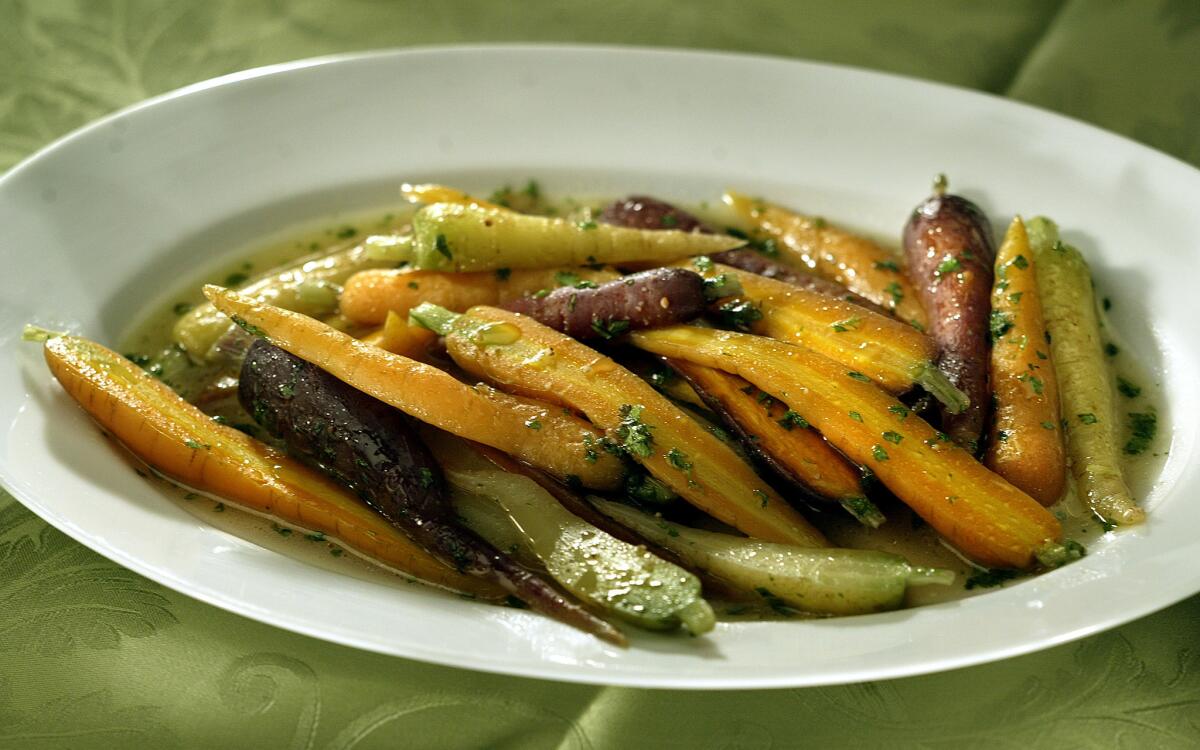Spring ragout of baby carrots

Long ago, back in the dawn of human prehistory (or so I imagine), people made the discovery that separates us from rabbits.
And if you, in this just-arrived season of sweet, tender, bursting-with-flavor baby vegetables, can be just a tiny bit patient, you can make this discovery too.
Sure, it’s tempting to eat every one of those little carrots as you pull them from the dirt, or gobble up all those petite green peas straight from the shell on the way home from the farmers market.
But there’s also a way to get them to the dinner table with their glorious color and freshness and newness intact. You just have to treat them right -- which in this case means gently. The result will be a very light, less-is-more, springtime vegetable ragout.
Just grasp the exceedingly easy technique, and you can present any combination of new-season vegetables that speak to you at the market or emerge from your garden. Fava beans, baby carrots in orange, yellow and red, baby turnips, baby fennel, baby beets and spring onions, as well as sweet young peas, pencil-thin asparagus and slim young parsnips all take well to the technique.
With recipes this simple, success lies in selecting the freshest, best-quality ingredients and carefully monitoring the cooking time. Use good unsalted butter for sauteing and have a good quality stock on hand for finishing.
First choose one, two or a combination of vegetables, pairing those that complement each other: Think not only of flavor but also of the colors and shapes of the vegetables, characteristics that affect both the dish’s appearance and cooking times.
Decide what vegetables need to be blanched (briefly precooked in boiling, salted water) and which should be cut up. Hard vegetables such as carrots, parsnips and potatoes need to be blanched in salted water just until they are tender, usually 1 to 3 minutes, depending on the vegetable. When they are precooked this way, they will finish cooking at the same time as the softer vegetables. Green vegetables such as peas and asparagus should also be blanched to preserve their bright color.
Even small, young carrots, parsnips and turnips should be cut in half before blanching for even cooking. The pencil-thin baby fennel you can occasionally find at farmers markets, on the other hand, can be left whole and blanched, but most baby fennel should be halved or quartered vertically, and perhaps cut in half horizontally too.
Use the same pot of boiling water -- salted enough to taste like the sea -- to blanch the vegetables one after another in quick succession, removing them as they’re done with a strainer or slotted spoon.
Next, saute them quickly (just 2 or 3 minutes) in butter.
The third and final step is a very brief moment of braising -- adding a bit of stock or water to the sauteed vegetables. Cover and steam the vegetables until they’re tender, usually a mere 5 to 7 minutes, depending on the vegetables. Choose a light stock -- vegetable stock, veal or chicken -- or water so the fresh vegetable flavors aren’t overwhelmed.
When the vegetables are tender, check the sauce to see if it is slightly syrupy. If the sauce looks too thin, remove the vegetables to a platter and reduce the sauce for a minute or so until it has thickened slightly, then spoon it over the cooked vegetables.
Don’t tarry in getting the ragout to the table -- it needs to be served immediately. After all, you’ve been waiting to eat those gorgeous vegetables since the moment they were picked.
Trim the tops and stems from the carrots, leaving about one-fourth inch of the stem. Wash the carrots under running water and scrub with a vegetable brush. Cut each in half lengthwise.
Blanch the carrot halves in a pot of boiling, salted water just until tender, about 2 minutes. Drain.
Heat the butter in a large skillet over medium heat. Add the carrots, season with salt and pepper and cook, stirring, 2 to 3 minutes.
Add the chicken stock, cover and simmer over low heat until the carrots are tender, about 5 minutes. Sprinkle with the chervil and stir lightly before serving.
Get our Cooking newsletter.
Your roundup of inspiring recipes and kitchen tricks.
You may occasionally receive promotional content from the Los Angeles Times.















